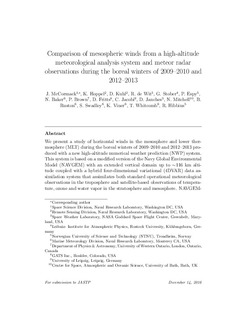| dc.contributor.author | McCormack, J | |
| dc.contributor.author | Hoppel, K | |
| dc.contributor.author | Kuhl, D | |
| dc.contributor.author | de Wit, R | |
| dc.contributor.author | Stober, G. | |
| dc.contributor.author | Espy, Patrick Joseph | |
| dc.contributor.author | Baker, N | |
| dc.contributor.author | Brown, P | |
| dc.contributor.author | Fritts, D | |
| dc.contributor.author | Jacobi, C. | |
| dc.contributor.author | Janches, D | |
| dc.contributor.author | Mitchell, N. | |
| dc.contributor.author | Ruston, B | |
| dc.contributor.author | Swadley, S | |
| dc.contributor.author | Viner, K | |
| dc.contributor.author | Whitcomb, T | |
| dc.contributor.author | Hibbins, Robert | |
| dc.date.accessioned | 2019-04-16T06:54:09Z | |
| dc.date.available | 2019-04-16T06:54:09Z | |
| dc.date.created | 2017-07-11T12:40:11Z | |
| dc.date.issued | 2017 | |
| dc.identifier.citation | Journal of Atmospheric and Solar-Terrestrial Physics. 2017, 154 132-166. | nb_NO |
| dc.identifier.issn | 1364-6826 | |
| dc.identifier.uri | http://hdl.handle.net/11250/2594715 | |
| dc.description.abstract | We present a study of horizontal winds in the mesosphere and lower thermosphere (MLT) during the boreal winters of 2009–2010 and 2012–2013 produced with a new high-altitude numerical weather prediction (NWP) system. This system is based on a modified version of the Navy Global Environmental Model (NAVGEM) with an extended vertical domain up to ∼116 km altitude coupled with a hybrid four-dimensional variational (4DVAR) data assimilation system that assimilates both standard operational meteorological observations in the troposphere and satellite-based observations of temperature, ozone and water vapor in the stratosphere and mesosphere. NAVGEM-based MLT analyzed winds are validated using independent meteor radar wind observations from nine different sites ranging from 69°N–67°S latitude. Time-averaged NAVGEM zonal and meridional wind profiles between 75 and 95 km altitude show good qualitative and quantitative agreement with corresponding meteor radar wind profiles. Wavelet analysis finds that the 3-hourly NAVGEM and 1-hourly radar winds both exhibit semi-diurnal, diurnal, and quasi-diurnal variations whose vertical profiles of amplitude and phase are also in good agreement. Wavelet analysis also reveals common time-frequency behavior in both NAVGEM and radar winds throughout the Northern extratropics around the times of major stratospheric sudden warmings (SSWs) in January 2010 and January 2013, with a reduction in semi-diurnal amplitudes beginning around the time of a mesospheric wind reversal at 60°N that precedes the SSW, followed by an amplification of semi-diurnal amplitudes that peaks 10–14 days following the onset of the mesospheric wind reversal. The initial results presented in this study demonstrate that the wind analyses produced by the high-altitude NAVGEM system accurately capture key features in the observed MLT winds during these two boreal winter periods. | nb_NO |
| dc.language.iso | eng | nb_NO |
| dc.publisher | Elsevier | nb_NO |
| dc.rights | Attribution-NonCommercial-NoDerivatives 4.0 Internasjonal | * |
| dc.rights.uri | http://creativecommons.org/licenses/by-nc-nd/4.0/deed.no | * |
| dc.title | Comparison of mesospheric winds from a high-altitude meteorological analysis system and meteor radar observations during the boreal winters of 2009-2010 and 2012-2013 | nb_NO |
| dc.type | Journal article | nb_NO |
| dc.type | Peer reviewed | nb_NO |
| dc.description.version | acceptedVersion | nb_NO |
| dc.source.pagenumber | 132-166 | nb_NO |
| dc.source.volume | 154 | nb_NO |
| dc.source.journal | Journal of Atmospheric and Solar-Terrestrial Physics | nb_NO |
| dc.identifier.doi | 10.1016/j.jastp.2016.12.007 | |
| dc.identifier.cristin | 1481892 | |
| dc.relation.project | EC/H2020/653980 | nb_NO |
| dc.description.localcode | © 2016. This is the authors’ accepted and refereed manuscript to the article. Locked until 24.12.2018 due to copyright restrictions. This manuscript version is made available under the CC-BY-NC-ND 4.0 license http://creativecommons.org/licenses/by-nc-nd/4.0/ | nb_NO |
| cristin.unitcode | 194,66,20,0 | |
| cristin.unitname | Institutt for fysikk | |
| cristin.ispublished | true | |
| cristin.fulltext | postprint | |
| cristin.qualitycode | 1 | |

